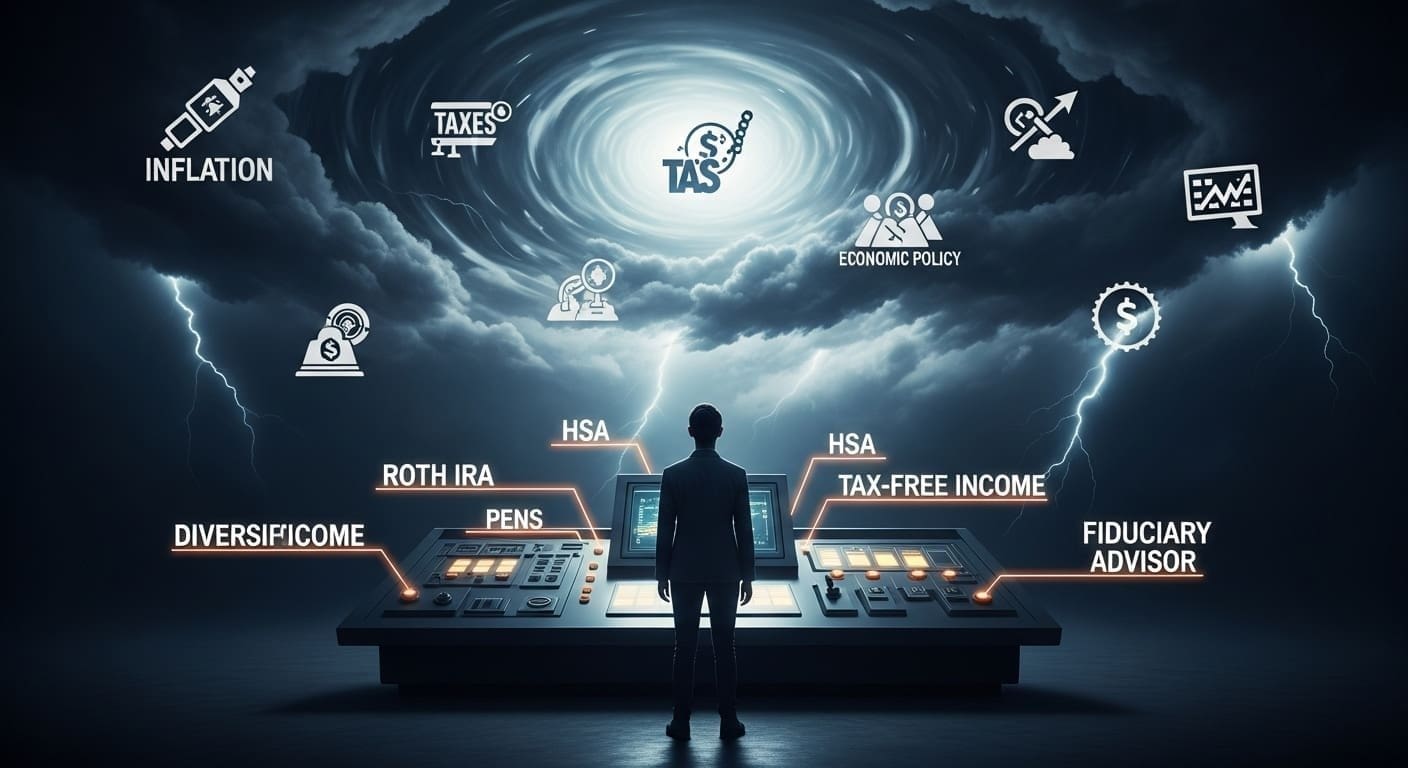6 Wealth Protection Strategies for Policy Uncertainty in 2025 has reached historic levels. With trade policy uncertainty hitting 900 points—a tenfold increase from recent averages—and financial market volatility tripling to 52 points, protecting your wealth has never been more critical. The good news? You don’t need millions to implement proven wealth protection strategies that work for everyday earners.
Table of Contents
- Understanding 2025’s Policy Uncertainty Landscape
- Tax-Advantaged Account Strategies
- Diversification and Asset Protection
- Advanced Tax Planning Techniques
- Professional Guidance and Estate Planning
- Implementation Timeline and Action Steps
- Frequently Asked Questions
Understanding 2025’s Policy Uncertainty Landscape
The Current Economic Reality
According to the Bank for International Settlements 2025 report, we’re facing unprecedented policy volatility. Trade tensions have escalated dramatically, with tariffs reaching 145% on US imports from China and 125% on Chinese imports from the US.
Key Uncertainty Drivers in 2025
Trade Policy Volatility:
- APEC data shows trade policy uncertainty at 900 points vs. 85-point average (2015-2024)
- Frequent policy reversals creating market instability
- Supply chain disruptions affecting global commerce
Financial Market Stress:
- Global volatility index spiked to 52 points in April 2025
- Gold prices reached record $3,200 per troy ounce
- Investor flight to safe-haven assets intensifying
Inflation and Monetary Policy:
- US inflation running close to 3% with tariff pressures
- Central bank policy divergence between US and global peers
- Interest rate uncertainty affecting long-term planning
Impact on Everyday Americans and Canadians
Real-World Consequences:
- Retirement account volatility affecting 401(k) and RRSP values
- Currency fluctuations impacting cross-border workers
- Tax policy changes creating planning challenges
- Healthcare and education cost pressures
Tax-Advantaged Account Strategies
Strategy #1: Maximize Roth IRA Contributions
2025 Contribution Limits:
- Under 50: $7,000 annually
- 50 and older: $8,000 annually (catch-up contribution)
- Income limits: $138,000-$153,000 (single), $218,000-$228,000 (married filing jointly)
Why Roth IRAs Excel During Uncertainty:
Tax-Free Growth and Withdrawals
Unlike traditional retirement accounts, Roth IRAs provide tax-free growth and withdrawals in retirement. With potential tax rate increases due to fiscal pressures, paying taxes now at known rates protects against future uncertainty.
No Required Minimum Distributions
Traditional IRAs force withdrawals starting at age 73, but Roth IRAs have no RMDs during your lifetime. This flexibility is crucial when tax policies are unpredictable.
Early Access Options
Roth IRA contributions (not earnings) can be withdrawn penalty-free anytime, providing emergency liquidity without tax consequences.
Real-World Example:
Sarah, a 32-year-old teacher from Denver earning $55,000, contributes $300 monthly to her Roth IRA. Over 30 years at 7% average returns, her $108,000 in contributions could grow to over $680,000—completely tax-free in retirement.
Strategy #2: Health Savings Account Triple Tax Advantage
2025 HSA Contribution Limits:
- Individual coverage: $4,300
- Family coverage: $8,550
- 55+ catch-up: Additional $1,000
The HSA Advantage:
Triple Tax Benefits
- Tax-deductible contributions reduce current taxable income
- Tax-free growth on investments within the account
- Tax-free withdrawals for qualified medical expenses
Retirement Healthcare Strategy
After age 65, HSA funds can be used for any purpose (with income tax on non-medical uses), essentially becoming a traditional IRA with better tax treatment during accumulation.
Strategic Implementation:
- Pay current medical expenses out-of-pocket when possible
- Save receipts for future reimbursement
- Invest HSA funds for long-term growth
- Use as supplemental retirement account
Case Study:
Mike and Lisa, both 35, contribute $8,550 annually to their family HSA. Investing conservatively at 6% returns, they could accumulate over $570,000 by age 65—all potentially tax-free for medical expenses.

Diversification and Asset Protection
Strategy #3: Tax Bucket Diversification
The Three-Bucket Approach:
Bucket 1: Tax-Deferred (Traditional Accounts)
- 401(k), 403(b), Traditional IRAs
- Tax benefit: Deductions now, taxes later
- Best for: High current income, expecting lower retirement tax rates
Bucket 2: Tax-Free (Roth Accounts)
- Roth IRA, Roth 401(k), HSA
- Tax benefit: Taxes now, tax-free later
- Best for: Lower current income, expecting higher future tax rates
Bucket 3: Taxable (Brokerage Accounts)
- Individual investment accounts
- Tax benefit: Capital gains rates, withdrawal flexibility
- Best for: Goals before retirement, tax-loss harvesting
Optimal Allocation Strategy:
| Age Range | Tax-Deferred | Tax-Free | Taxable |
|---|---|---|---|
| 20-30 | 40% | 50% | 10% |
| 30-40 | 50% | 35% | 15% |
| 40-50 | 45% | 30% | 25% |
| 50-60 | 40% | 25% | 35% |
Strategy #4: Geographic and Currency Diversification
International Exposure Benefits:
- Protection against US-specific policy risks
- Currency diversification reducing dollar concentration
- Access to global growth opportunities
Implementation Options:
For US Investors
- International stock funds: Vanguard Total International (VTIAX)
- Emerging markets exposure: 10-15% of equity allocation
- Foreign bond funds: Hedged and unhedged options
For Canadian Investors
- US market exposure: Reduces dependence on Canadian economy
- Currency hedging considerations: USD strength vs. CAD volatility
- TFSA optimization: Maximize tax-free international growth
Real-World Application:
Jennifer from Toronto allocates her RRSP as follows: 40% Canadian equities, 35% US equities, 15% international developed markets, 10% bonds. This diversification protected her during the 2025 trade tensions when Canadian markets underperformed.
Advanced Tax Planning Techniques
Strategy #5: Roth Conversion Strategies
When Roth Conversions Make Sense:
Low-Income Years
- Between jobs or career transitions
- Early retirement before Social Security
- Business losses creating tax opportunities
Market Downturns
- Convert when account values are temporarily depressed
- Pay taxes on lower converted amounts
- Benefit from tax-free recovery
2025 Conversion Opportunities:
With market volatility creating temporary account value dips, strategic conversions can lock in tax-free growth on the recovery.
Conversion Ladder Strategy:
Instead of converting large amounts in one year, spread conversions over multiple years to manage tax brackets.
Example Conversion Plan:
Tom, 58, has $400,000 in traditional IRA. Rather than converting all at once, he converts $50,000 annually for 8 years, staying within the 22% tax bracket and avoiding higher rates.
Strategy #6: Tax-Loss Harvesting and Asset Location
Tax-Loss Harvesting Benefits:
- Offset capital gains with realized losses
- Deduct up to $3,000 annually against ordinary income
- Carry forward unused losses indefinitely
Asset Location Optimization:
Tax-Inefficient Investments (Hold in Tax-Advantaged Accounts)
- REITs and high-dividend stocks
- Actively managed funds with high turnover
- Bonds and bond funds
Tax-Efficient Investments (Hold in Taxable Accounts)
- Index funds with low turnover
- Individual stocks held long-term
- Municipal bonds (for high earners)
Advanced Strategy: Tax-Managed Funds
These funds specifically minimize taxable distributions through:
- Index-based approaches
- Tax-loss harvesting at fund level
- Avoiding dividend-paying stocks
Professional Guidance and Estate Planning
Working with Fee-Only Fiduciary Advisors
Why Fiduciary Standard Matters:
- Legal obligation to act in your best interest
- No commission-based product sales
- Transparent fee structures
Finding the Right Advisor:
Credentials to Look For
- CFP (Certified Financial Planner): Comprehensive planning focus
- CPA/PFS (Personal Financial Specialist): Tax expertise
- ChFC (Chartered Financial Consultant): Insurance and estate planning
Fee Structures
- Assets Under Management (AUM): 0.5-1.5% annually
- Hourly rates: $200-500 per hour
- Project-based: $2,000-10,000 for comprehensive plans
Questions to Ask Potential Advisors:
- Are you a fiduciary 100% of the time?
- How are you compensated?
- What’s your investment philosophy?
- How do you handle conflicts of interest?
- Can you provide client references?
Estate Planning Essentials
Basic Estate Planning Documents:
Essential Documents for Everyone
- Will: Asset distribution and guardian designation
- Power of Attorney: Financial decision-making authority
- Healthcare Directive: Medical decision preferences
- HIPAA Authorization: Medical information access
Advanced Strategies for Larger Estates
Charitable Remainder Trusts (CRTs):
- Avoid capital gains taxes on appreciated assets
- Receive lifetime income stream
- Support charitable causes
- Reduce estate tax burden
CRT Example:
David owns $500,000 in appreciated stock (basis $100,000). Instead of selling and paying $60,000 in capital gains taxes, he transfers it to a CRT, receives 5% annual income ($25,000), and the remainder goes to charity at his death.
Irrevocable Life Insurance Trusts (ILITs):
- Remove life insurance from taxable estate
- Provide liquidity for estate taxes
- Protect benefits from creditors
Implementation Timeline and Action Steps
30-Day Quick Start Plan
Week 1: Assessment and Account Setup
- Review current account types and balances
- Calculate 2025 contribution limits for all accounts
- Open Roth IRA if you don’t have one
- Research HSA eligibility through employer
Week 2: Contribution Optimization
- Set up automatic Roth IRA contributions
- Increase 401(k) contribution to employer match
- Fund HSA to maximum if eligible
- Review beneficiary designations on all accounts
Week 3: Investment Allocation
- Assess current portfolio diversification
- Rebalance to target asset allocation
- Consider international exposure if lacking
- Evaluate expense ratios and fund quality
Week 4: Professional Consultation
- Schedule meeting with fee-only financial advisor
- Gather documents for tax planning review
- Research estate planning attorney if needed
- Create ongoing monitoring schedule
90-Day Comprehensive Strategy
Month 1: Foundation Building
- Complete 30-day quick start plan
- Establish emergency fund in high-yield savings
- Optimize employer benefits (insurance, FSA, etc.)
- Begin tax-loss harvesting if applicable
Month 2: Advanced Implementation
- Execute Roth conversion if beneficial
- Implement tax bucket diversification
- Consider charitable giving strategies
- Review and update insurance coverage
Month 3: Long-Term Planning
- Develop 5-year financial plan
- Estate planning document creation/updates
- Investment policy statement development
- Quarterly review schedule establishment
Annual Review Checklist
Tax Planning (December):
- Roth conversion opportunities
- Tax-loss harvesting
- Charitable giving timing
- Retirement account contributions
Investment Review (Quarterly):
- Portfolio rebalancing
- Performance evaluation
- Fee analysis
- Asset allocation adjustments
Estate Planning (Every 3-5 Years):
- Document updates
- Beneficiary reviews
- Trust funding
- Insurance needs analysis

Frequently Asked Questions
How much should I prioritize wealth protection vs. growth in 2025?
The optimal balance depends on your age, risk tolerance, and financial goals. However, given current policy uncertainty, most financial advisors recommend increasing defensive allocations by 5-10% compared to normal times. For example, if you typically hold 80% stocks/20% bonds, consider 70% stocks/30% bonds with higher-quality, shorter-duration bonds.
Age-based guidelines:
- 20s-30s: Still prioritize growth but add 5-10% to cash/bonds
- 40s-50s: Increase defensive allocation to 40-50%
- 60s+: Focus heavily on capital preservation with 50-70% defensive assets
Should I pause investing during policy uncertainty?
No. Trying to time markets based on policy uncertainty typically leads to poor outcomes. J.P. Morgan research shows that staying invested through uncertainty periods generally produces better long-term results than attempting to time entries and exits.
Better strategies:
- Maintain regular contributions (dollar-cost averaging)
- Increase cash reserves for opportunities
- Focus on quality investments
- Rebalance more frequently
How do I protect against inflation during policy uncertainty?
Immediate protection strategies:
- Treasury Inflation-Protected Securities (TIPS): Direct inflation hedge
- Real estate exposure: REITs or direct property ownership
- Commodity exposure: Precious metals, energy, agriculture
- International stocks: Currency diversification benefits
Long-term strategies:
- Equity ownership: Stocks historically outpace inflation
- Fixed-rate debt: Inflation reduces real debt burden
- Skills investment: Education and training maintain earning power
Are Roth conversions still smart if tax rates might not increase?
Yes, for several reasons beyond tax rate arbitrage:
- Flexibility: No required minimum distributions
- Estate planning: Tax-free inheritance for heirs
- Healthcare costs: Tax-free withdrawals for medical expenses
- Geographic arbitrage: Move to lower-tax states in retirement
Even if tax rates remain stable, the additional flexibility often justifies conversion costs.
How much should I keep in cash during uncertain times?
Emergency fund guidelines:
- Stable employment: 3-6 months of expenses
- Variable income: 6-12 months of expenses
- Business owners: 12+ months of expenses
Additional cash considerations for 2025:
- Opportunity fund: 5-10% of portfolio for market dislocations
- Policy hedge: Extra 1-2 months expenses for potential disruptions
- High-yield savings: Earn 4%+ while maintaining liquidity
Should Canadians invest in US markets given policy uncertainty?
Yes, but with considerations:
- Diversification benefits: Reduces dependence on Canadian economy
- Currency hedging: Consider hedged vs. unhedged exposure
- Tax efficiency: Use TFSA and RRSP for US investments
- Withholding taxes: Understand tax treaty implications
Recommended allocation: 30-40% US exposure for most Canadian investors, adjusted based on personal circumstances.
How often should I review my wealth protection strategies?
Quarterly reviews:
- Portfolio rebalancing
- Performance assessment
- Market condition changes
- Policy development monitoring
Annual comprehensive review:
- Tax planning strategies
- Estate plan updates
- Insurance needs analysis
- Goal adjustment
Trigger-based reviews:
- Major policy announcements
- Significant market moves (>10%)
- Personal life changes
- Economic regime shifts
What’s the biggest mistake people make during uncertain times?
Emotional decision-making. The biggest wealth destroyer during uncertainty is making dramatic portfolio changes based on fear or greed. BNP Paribas research shows that investors who maintain disciplined approaches during volatile periods significantly outperform those who make frequent changes.
Common mistakes to avoid:
- Selling everything during market drops
- Chasing performance in hot sectors
- Abandoning long-term plans for short-term concerns
- Failing to rebalance during volatility
Better approach: “Control the controllables”—focus on what you can influence (savings rate, asset allocation, tax efficiency) rather than what you can’t (policy outcomes, market timing).
Want to Keep Strengthening Your Finances?
If you found this article helpful, you might enjoy some of our other popular posts that dive deeper into saving, investing, and smart money management:
- Best No-Penalty CD Rates of 2025
- Best High-Yield Savings Accounts 2025
- 8 Powerful Financial Strategies Every Single Person Should Know
- The 10 Best Financial Wellness Apps That Track Mental Health in 2025
- The 10 Best Financial Wellness Apps That Track Mental Health in 2025
- 2025 401(k) Limits: Save $34,750 + Super Catch-Up Guide
Keep exploring — your smartest financial years are just getting started.
Sources:
- Bank for International Settlements Annual Report 2025
- APEC Policy Uncertainty Analysis 2025
- OECD Global Economic Outlook 2025
- J.P. Morgan 2025 Outlook Update
- BNP Paribas Corporate Risk Management Outlook 2025
- IRS Retirement Plan Contribution Limits 2025
- Canada Revenue Agency RRSP Guidelines
- Federal Reserve Open Market Operations
- Bank of Canada Monetary Policy
- SEC Investment Adviser Regulation
Disclaimer: This article is for educational purposes only and does not constitute financial advice. Policy conditions and investment markets are subject to change. Tax laws vary by jurisdiction and individual circumstances. Always consult with qualified financial and tax professionals before making significant financial decisions. Past performance does not guarantee future results.




